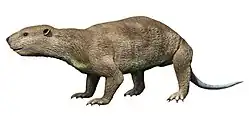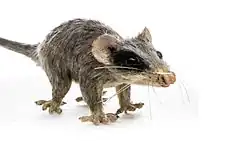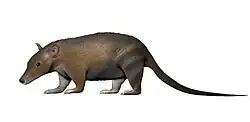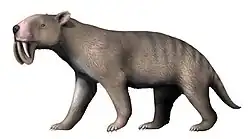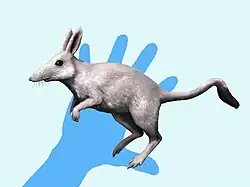Gurbanodelta
| Gurbanodelta Temporal range: Late Paleocene
~ | |
|---|---|
| Scientific classification | |
| Kingdom: | Animalia |
| Phylum: | Chordata |
| Class: | Mammalia |
| Order: | †Deltatheroida |
| Family: | †Deltatheridiidae |
| Genus: | † Xinjun Ni et al, 2016 |
| Species | |
| |
Gurbanodelta kara is an extinct genus of metatherian mammal. A deltatheroid, it represents the geologically youngest member of this clade, dating to the late Paleocene of China.[1]
Description
Gurbanodelta kata is known from upper molars. They are the smallest sized among deltatheroideans, suggesting that it was a small, shrew-sized mammal.[1]
Classification
Gurbanodelta kara nests deeply within Deltatheridiidae. Its closest relative is the largest known deltatheroidean, Nanocuris.[1]
Size reduction
Deltatheroideans are relatively large carnivorous mammals. By contrast, Gurbanodelta kara is a small sized species. This indicates a size reduction that potentially allowed it to survive the KT event, likely switching to an insectivorous diet.[1]
References
- ^ a b c d Ni, Xijun; Li, Qiang; Stidham, Thomas A.; Li, Lüzhou; Lu, Xiaoyu; Meng, Jin (2016). "A late Paleocene probable metatherian (?deltatheroidan) survivor of the Cretaceous mass extinction". Scientific Reports. 6. Springer Science and Business Media LLC: 38547. Bibcode:2016NatSR...638547N. doi:10.1038/srep38547. PMC 5141426. PMID 27924847.
